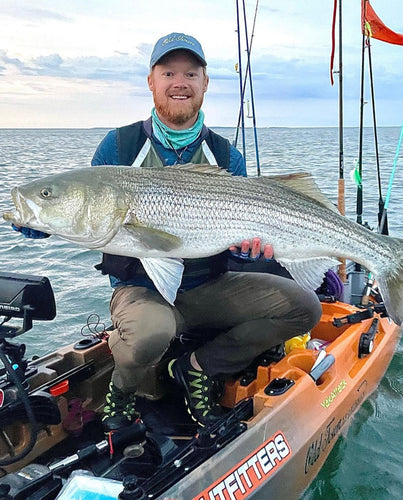Tog Tips

Pristine, starry skies framed by rusty amber trees in varying stages of limbed bareness. Sweatshirts and gloves in the morning, long sleeve t-shirts by lunch. A variety of shrink-wrapped boats dotting the shores of marinas and driveways. And a hearty handful of anglers rolling out of bed in the dark, dressing for warmth, clipping clingy crabs while ripping full speed into a rising October sun. Oh yeah baby, it’s tog season!
What a blast this time of year is out on the water. Fewer boats, arguably (at times) some of the best weather of the year, and still, despite the number of anglers who’ve already packed it in for the season, an absurd amount of fish to be caught before things truly wind down for the year. Some still pine for stripers and blues, others cover ground trying to catch a glimpse of slashing albies, but most are focused on one fish only: tautog, also known colloquially as blackfish or tog. Tog are bulldogs of the boulders, pound for pound some of the hardest fighting fish in our waters, and this is prime time to grab a bucket of crabs, a handful of jigs, and some friends, and spend the day enjoying what is usually non-stop action bottom fishing and soaking in the final few days of the year out on our beloved Sound.
Catching tog is equally fun from boat and kayak, and many even target these tasty fish from shore. Regardless of your method, and despite the general simplicity of using crabs as bait and bottom-fishing, there are a few tips and tricks to try that might help you land a mega tog, or at least limit out and set yourself up for some delicious fish for dinner. Here are a few things to keep in mind and try out while you’re out there enjoying the awesome fall fishing.
1. Bring ‘em in, then Upsize
Before the water temperature really drops and tog are one of the only species actively feeding, there are many “bait-stealer” species that will quite happily peck your crabby bait to death within seconds of it dropping to the bottom. John Skinner made a video late last year showing what happens down on the bottom when a crab is dropped, and it’s absolute carnage. This maelstrom of fish, from cunner to micro-tog, tiny seabass, big seabass, porgy, and even schoolie stripers, can make it tough to truly target keeper-sized tog. You end up re-baiting literally every 30 seconds and as a result your bait spends less time down on the bottom where you want it.
One tip to try and lessen the impact of these other fish is to use half-crabs when you first arrive at your spot, and then switch to whole crabs once the bite is established. Either that, or, if you truly know there are good tog in your spot, just use whole crabs from the start. Often, those pest species will be less willing to go for an entire crab, whereas a large tog will not hesitate.
Sometimes, especially during spring tog season, I like to use half-crabs and their glorious juiciness to build a bite and lure in fish from the general area by scent and sound. The sound of fish crunching on crab shells draws in those fish that perhaps are around but not able to see your bait. In the spring, when bait-stealers are scarce, this is a great tactic to pull tog into your area. In the fall, I find that using half crabs can occupy the bait-stealers and draw in bigger tog, but not cause you to rip through as many crabs. Once a bite is established, switching to whole crabs can be the catalyst to make those bigger tog, which might be in the area but unwilling to enter the tornado of bait-stealers for a ripped up half-crab, finally crunch down on your offering. It also sometimes seems like the bigger tog stay on the edge of the fray. So, once you’ve built a bite dropping half-crabs in the same spot for a bit, try a whole-crab cast a few feet in another direction.
2. Always Hunt for New Structure
Sometimes, the “hot” tog spots are deemed such because of the sheer number of anglers fishing them. At some point, if ten boats are fishing the same rockpile, the big fish will be caught there. Word of mouth spreads, photos are taken, then all of sudden a very noticeable, very common piece of structure becomes the place to be. And it probably is a decent spot. But, whether it’s because I enjoy the solitude of fishing, or because I’m in a kayak and tend to avoid the crowds, I don’t always like to fish the really obvious pieces of structure like rocky points and jetties. When looking for new structure, try to remember that tog aren’t picking their homes based on what sticks up above the water. While that is certainly indicative of a big piece of structure for anglers, there’s an absurd amount of structure below the surface that we never see, but which could be only a couple dozen yards from more commonly pressured spots.
Assuming you’re using a fish-finder, become familiar with the button you need to push to mark a waypoint while on the move. Then, while traveling, keep your eyes on the screen. If you see a subtle, or not-so-subtle piece of structure, mark that thing and spend 20 minutes fishing it. Who cares if it’s not the spot everyone is chattering about, or one that shows up on publicly available bathymetric maps. The tog certainly don’t take those factors into consideration, so you shouldn’t either. If you keep an open mind about structure-hunting and avoid the temptation to pack it in tight with other boats, I guarantee you’ll end up finding a spot which is very-likely less-pressured and perhaps even accidentally discover your new honey-hole.
3. “Hold…HOLD….HOLD!” -William Wallace
You heard the man…hold! Who knew that William Wallace’s epic Braveheart scene could translate to tog fishing. But hey, here we are! And it does fit…you’ve got to hold off on setting the hook sometimes. It’s one of the hardest skills for new tog anglers to learn. Usually, in fishing, you get a bite and you set the hook- pretty straightforward stuff. However, if you’ve spent any particular amount of time tog fishing you know that there is a distinct feeling on the end of the line that comes from the crunch of a solid blackfish. Ever been eating something with a metal fork and accidentally bite down on the tongs? It’s a horrible feeling, but that’s the best way I can describe how a solid tog feels when it really chomps down on my crab. The bites of many of the bait-stealers can feel more mushy in contrast, whereas a big tog bite truly reminds me of a human tooth violently cracking down on a fork tong.
Tog fishing can be surprisingly nuanced. While it can look pretty darn simple on the surface, pun intended, there are many very detailed aspects of it that separate those who consistently land the pool winner from those who spend the day getting spined by obnoxious 8-inch porgy. One of those details is learning to hold off on setting the hook when you first feel a bite. This will do two things. Primarily, it gives those smaller fish time to pick away pieces of bait that will hopefully occupy them for a few seconds, giving the targeted tog more time to move in for a bite. Additionally, it will give you time to really confirm whether what you’re feeling is the white-chinner you’re looking for, rather than a nuisance fish. Often, when I can feel only nuisance-fish bites, I’ll slowly lift and reposition my bait, hopefully landing it closer to the mouth of a nice blackfish. There’s really nothing you can do to entirely avoid the bait-stealers, but this can help lessen their impact and increase the odds that you set the hook into a porkchop of a tog.
4. Change Spots Often…or not at all
What an annoying title, right? But it’s true. You’ve got to know what structure you’re fishing and let that determine how much time you spend there. I typically decide this based on the size and shape of what I’m fishing. Let’s say, for example, I’m fishing a boulder which I know from side-scan is about the size of an SUV. I can assume that any fish there will either see or be drawn to my bait within about a half hour. If the action is good, I’ll keep picking through whatever is biting and hope the biggun of the bunch makes itself known. But if the action is sporadic, I can assume based on the size of those boulders that there just might not be many fish there at all, or at least many active fish at that moment- Time to move. This is not, however, the same strategy I’d use when fishing longer, more jagged, or more oddly shaped structure.
While tog do tend to find a piece of structure and call it home for a period of time, they also move along the length of that object throughout days and tides. So, if I’m fishing a jetty, and my bite starts slow, I’m much less likely to move right away and much more likely to keep using half-crabs to try and draw in those fish as they cruise back and forth along the jetty. Just because those fish aren’t there initially doesn’t mean that you can’t draw them in or that the tide won’t cause them to become more active over time. A jetty is a large, detailed, jagged piece of structure, and in my mind that warrants much more time dedicated to trying to build a bite on it than on the smaller boulder pile from the first example. This same mindset goes for longer and bigger rocks or structure with many edges. So, before pulling anchor and moving on, think about what type of structure you’re fishing and decide whether you really should hop to another location or perhaps give the current area a bit more time, perhaps from a new angle or casting at a different distance.
In conclusion, tog fishing is much more nuanced and detailed than people give it credit for. That’s not to say that you can’t catch a limit by anchoring up to a well-known spot and just going all out for a few hours. But there are actions you can take to try and enhance your chances at locking into a giant. As any good tog angler can tell you, though, hooking the giant ones is barely even half the battle. The fight of a double-digit tog is perhaps more violent and angry than that of any other fish in our waters. Not to mention, they’re absolutely delicious. So, before you shrink wrap the boat and call it quits for the year, get out there and try these tips to see if you can create one more fishing memory this season. Time spent on the water is never, ever wasted, and that’s especially true when dunking crabs for these beasts in the boulders.
Matt Stone is a kayak angler and freelance writer based in Chester, Connecticut. He can be found on Instagram at @sunrisekayakfishing, where he documents his pursuit of saltwater gamefish, most notably striped bass, false albacore, and tautog.
Tags
bait-stealer
blackfish
fishing
fishing tips
green crabs
john skinner
tautog
tog




